Making Cheezoo-Kaykee
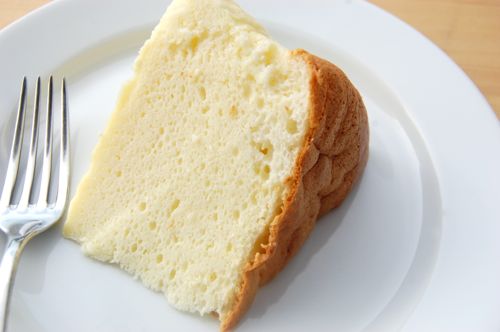
I’m not going to call this chiizukeiki or Japanese cheesecake, I’ve decided. I’m going to call it “cheesecake surprise.” Because let me tell you, I put a bite of this into my mouth convinced that I already knew what it was going to taste like…but I was completely surprised. For Japanese cheesecake has the feel of a dense soufflé or angelfood cake, but it has none of the dryness those sorts of egg foam-heavy foods can have. Instead it’s entirely moist, lightly sweet and smooth, and it vanishes off the tongue almost instantly, leaving nothing but a hint of New York behind. Remarkable.
For the record, this is not the Japanese cheesecake I’d hoped to make. I made a fairly significant — but not fatal — mistake that we’ll get into as we go along. For now, start by preheating your oven to 325 degrees Fahrenheit. Then prepare an 8″ springform pan according to the directions in the Techniques menu, and secure a pan large enough to hold the springform (this will be your water bath).

So then, start by placing your cream cheese, butter and milk in a microwave-safe bowl.
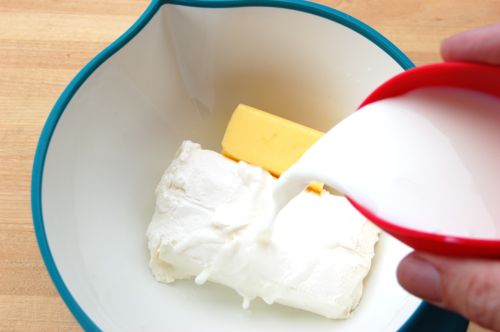
I know what you’re thinking: something looks different here, there are some colors in this picture than I’m not accustomed to on Joe Pastry. Well, the good folks at Trudeau kitchenware sent me a box of new toys recently, and these are some of them. No, Trudeau isn’t paying me to use and/or speak nicely about their products. But they gave me these things for free, and in exchange I’m only too glad to blog about them a bit (I hope you’re paying attention, high-end auto manufacturers!). This bowl with the spout and the broad lip is really pretty neat. It also has little rubber pads on the bottom that keep it from slipping around.
But where was I? Oh yes, zap the ingredients in the microwave for 10-15 seconds, stir and do it again until the mixture looks about like this.
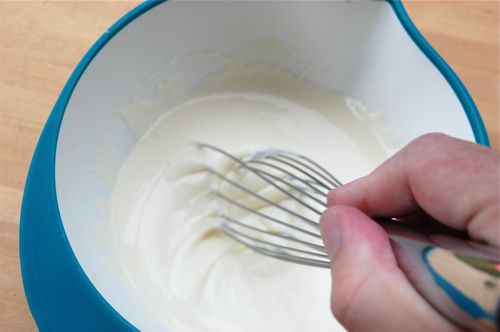
Now then for the egg yolks. Put them in a bowl and add the lemon juice (if you happen to have one of these nifty little squeezable bowls — also from Trudeau — that’s great).

Whisk the two together and pour into the cheese mixture.
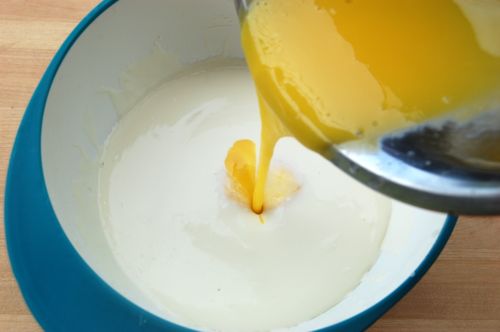
Whisk all that together.

Next, whisk together the flour and cornstarch (corn flour) in a small bowl. No, Trudeau didn’t give me this little mini-whisk, in case you were curious. Cool though, isn’t it?
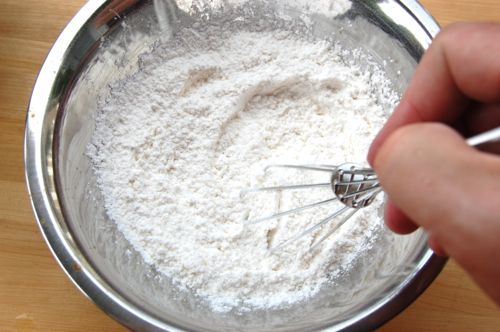
Sprinkle the flour mixture over the cheese mixture…
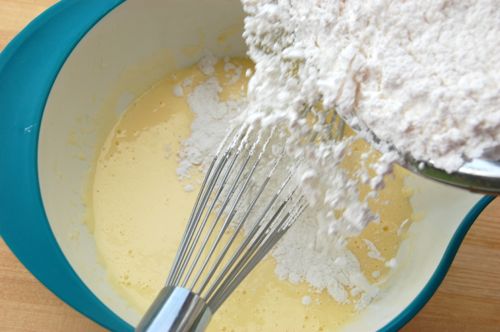
…and whisk it in.
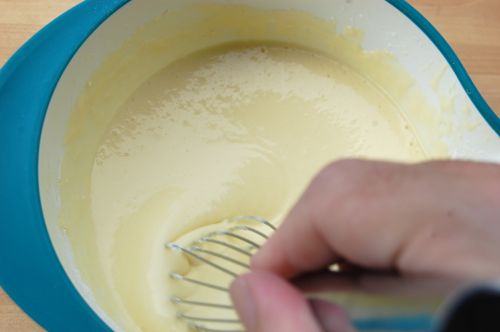
Now for the egg white foam. Combine the sugar, salt and cream of tartar in a bowl and whisk them together.
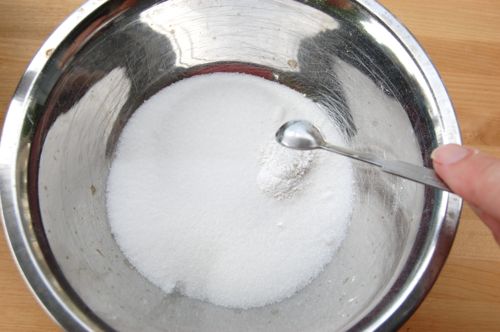
Place the whites in the bowl of a stand mixer fitted with a whip…
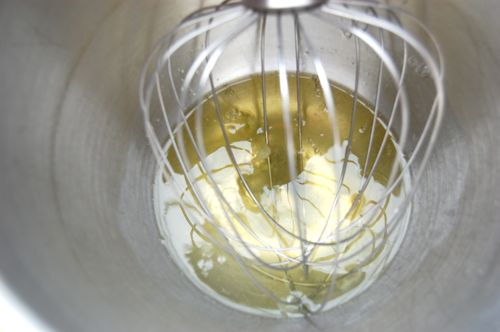
…and whip them until they’re foamy. Add the sugar mixture all at once…
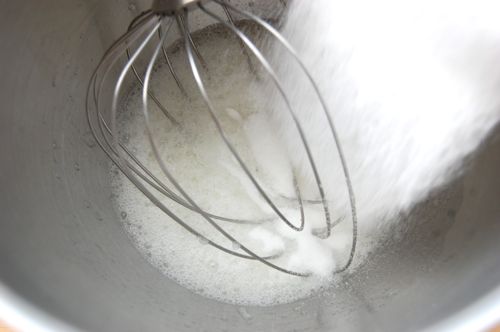
…and whip the mixture to the soft peak stage. Add the cheese mixture and, with the machine on low, stir it in.
This is the point where I made the mistake. I over-whipped the foam. See how those mounds are sitting there on the top? They shouldn’t be rigid like that — a sign of stiff peaks — they should just melt right back into the main mass soon after they drip off the whisk. What are the consequences of over-whipping? You’ll see.

Now then, pour the batter into the prepared pan (it’ll fill it up).
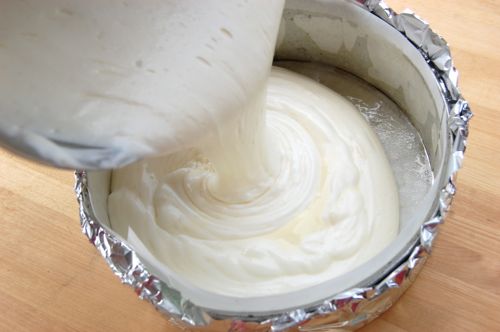
Put the cake pan into the larger pan and add hot water until the cake pan starts to want to float.
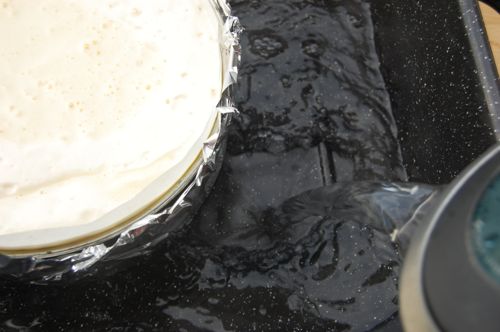
Bake it for 45 minutes, then check to see if it’s done. The top should be firm, browned and non-jiggly. If not, bake another 5-10 minutes.
Now then, see how high this cake is over the lip of the pan? That’s nothing. It was a full inch and a half higher when I took it out of the oven. It rose WAY too much. That was a result of the over-whipping of the whites.
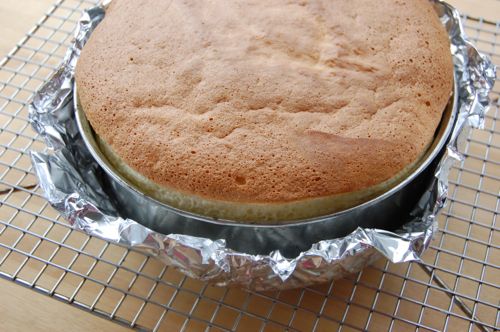
What’s the upshot of that (no pun intended)? A sort-of mushroom shape like this:
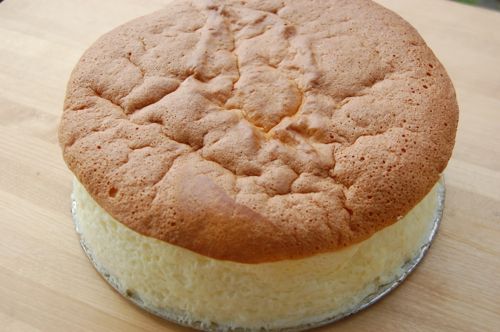
Why does an over-risen cake end up like that? Because in the heat of the oven the very bottom, being immersed in the water bath, sets up quickly and firms. So does the top, being exposed to hot air. The middle, well, that’s another story. The middle is the last part of the cake to firm because it’s furthest from the heat. Consequently, the middle is where most of the expansion happens.
As the bubbles in the batter expand, the top goes up. That’s a good thing. However if there are too many bubbles the top goes up, up, up, but the sides and middle get weaker as the bubble walls stretch. The top stays up as long as the cake is hot and the bubbles are fully inflated with steam. However as the cake cools the steam pressure drops. The bubble walls aren’t thick enough to support the weight of the top, which starts to come down. At the same the side walls get sucked in as the crumb contracts.
End result: this rather odd shape. Nobody at the picnic knew I’d messed up. I told them it was supposed to look that way. It also tasted great. But next time I’ll know to stop whipping those whites. Have a great weekend, everyone!
Oh. I guess I should follow instructions. I thought stiff peaks would work better…
I had the same thought at first — no problem!
But then….
😉
Lucky you..got the talent to make the best of cakes and now you get free equipment too..the gift (and the cake)looks great…! Wondering a little vanilla or lemon zest would add a zing to the cake.
I think either one or both would be terrific. As for the free gear, I was indeed happy to get it. They sent me a set of three of those plastic bowls, the little rubber ingredient bowls, four silicone muffin cups and a plastic whisk. Oh, and a little plastic egg separator…a little disk of plastic with drain holes in it. It wasn’t any sort of giant windfall, but I was grateful for it. Certainly better than the utility bills that usually come in the mail! And most of it is pretty clever stuff, to be honest. I love those little ingredient bowls…a truly great idea.
I see you write “cornstarch (corn flour).” I’m confused about that. I have cornstarch, which I use to thicken sauces when I don’t want it to be floury. Then I have corn flour, which I use to make soft corn tortillas. The corn flour is also called masa. Am I wrong in referring to my masa as corn flour? Is cornstarch actually corn flour? If it is, then what is masa? So many questions!
Hey Jacki!
The reason I wrote (corn flour) in there is because that’s what Brits call cornstarch. I don’t know if Aussies and Kiwis use the same term, but I’ve had folks write in from different parts of the globe asking me what the heck “cornstarch” is. So, that was me trying to be international. 😉
Use cornstarch, definitely not corn masa, meal or anything like that. Thanks for the email!
– Joe
Yes we do call it cornflour. It’s always confused me, as our main brand here in New Zealand has “pure wheaten cornflour” on its label, indicating that it’s actually not even made from corn. Perhaps the corn in question is the old fashioned English meaning of “grain”. Whatever, cornflour is just quite pure starch. You can probably replace it with rice flour or arrowroot too, wouldn’t you think?
PS. It’s “cornflour” – one word, as opposed to corn flour, which I would consider to be flour made from corn, and suitable for making tortillas. Subtle distinction.
Check! Thanks Bronwyn!
I suppose starch is starch at some level. I’ve never worked worked rice flour in that context, but arrowroot should work just fine.
Thanks again, B!
– Joe
Joe, you are making me *very* hungry right now.
Asides from that, the cake looks wonderful, mushroom shape and all! It seems like much less of a hassle to make this one than the matcha one I messed up royally years ago. I might just have to give it another go! You’ve given me more confidence in making chiizukeiki now 😀
Also, I’m not kidding – you need to set up shop here in Canada. ASAP. I swear, we’re nice folks up here AND we LOVE to eat. Especially Torontonians. Really. 😀
I’m sorely tempted, April! Trouble is the missus has tenure now, which means a guaranteed paycheck for life! I can’t see her walking away from that anytime soon, alas. But who knows? I sure love Toronto. I’d move there for the Chinese food alone.
– Joe
Oh. Dear. God.
That looks insane! Must make ASAP! Thanks!
It’s excellent. Had it occurred to me to serve it with fruit, I would have. There are many, many possible variations for this, obviously. A drizzle of some sort of fruit sauce wold put this over the top.
Please post the recipe.
Just scroll down, Linda!
Joe, I think part of the reason that you get requests like this is that for any of us directly linked to this post (e.g. RSS Readers, website like Reddit) it is not apparent that there is a previous post with a recipe in it. This will only get worse as time goes on as it becomes more difficult to comb through the archives to find the week or two of old posts that match the one we were linked to.
Not sure of a solution, but maybe a “related posts” pluggin for Word Press?
Hi Enekk!
That’s not a bad idea. I’ll look into it. What I will say, however is that I do archive the recipe and the tutorial together, so when you go looking for a specific recipe (or browse for one) everything’s together. But you’re offing a good suggestion, since people arriving at a tutorial via search don’t always understand how the blog is set up.
Thanks much!
-Joe
Thanks so much for taking on this project. This cake indeed looks just like the one I’ve been trying to recreate from my hometown bakery for many years. It was an Italian bakery, but for whatever reason, this seems to be the exact cake they made. I will definitely try it again soon. My sisters will be so excited when I tell them about this.
Let me know how close it is. I’ll be very curious!
– Joe
I wonder why most Japanese cheesecake recipes call for the cream cheese to be melted with milk, rather than to be softened and than creamed – surely the latter would create a more stable emulsion to bind with the egg white foam?
hi joe, now that you are venturing into unconquered shores, i have a request. French Apple Cake. My french friend once brought this for me from france, it was extraordinary, the smell of butter and nutmeg just blew me away. I couldn’t get the recipe from her as my french stinks too bad. I figured out it was made with brown sugar (not sure whether it was muscovado or turbinado; i get only demerera in India) and loads and loads of butter with home grown “red delicious” apples. Hope you consider my request soon. Thanks in advance
I shall try it! I have several apple requests for the coming months: German apple cake and strudel among them. I think I’m going to devote the month of October to apple desserts. What do you think?
Some Asian recipes call for baking at a lower temperature (150C) as well as leaving the cheesecake in the oven with the oven door open for ten minutes – both tactics are for reducing the sudden rise/shrinkage of the top that makes the finished product unsightly. Many commercial Japanese cheesecakes also have a gelatine glaze poured onto them after cooling.
Hmm…I may try that next time, Henry. Thanks!
Anyone wanting a fruit sauce, I made the poached nectarines in wine with berries that was in the New York Times last week and it is delicious. (Basically: poach the chunked fruit till tender but not disintegrated in two cups of wine to half a cup of sugar — leave the pits in while poaching; puree half your berries; strain out the fruit, discard the pits, add in the puree and reduce; add back the fruit and remaining berries, and a little lemon juice; framboise or other fruit brandy is optional. Chill several hours or overnight. Use raspberries and white wine or blackberries and red wine. I used a faintly petillant, cheap Portuguese white, and mixed in peach and plum with my nectarines.)
Sorry, I got carried away there, this is after all a post about cheesecake and not poached fruit!
No problem by me! Thanks for the excellent suggestion!
– Joe
This is a great, great recipe and a keeper. It’s all about the texture. But then again, I feel it needs some tangy-sweet (fruit) company. Plum-sauce works well and a good plain yogurt (sweetened or not) is fine too.
Talk about a proper protein-intake 🙂 a cake for bodybuilders (since it also works with low-fat cheese and no butter!).
Cheesecake fanatic that you are, I’ve been wondering when you were going to try this! But you’re right that Japanese cheesecake can be a little plain without some adornment. As you can imagine, there are scores of variations in Japan, many with fruit layers on the top. A google search will bring more than a few of them up.
Nice to hear from you,
– Joe
So I tried making this cheesecake this morning and followed your recipe to-the-tee. But mine turned out hard and dry, it’s not fluffy like yours. Well it was okay when I took it out of the oven, but after a few hours in the ridge, it was HARD. Maybe my cake flour was too low quality? I bought it at Kroger’s. Could you give me some pointers? I would really like to gift-give this to an elderly Japanese couple that I recently met. Thanks!
Hard and dry you say. Very sorry to hear that. Did it rise like mine did?
– Joe
It rose a bit in the oven, but it deflated an hour after I took it out. It was dense and chewy instead of airy and fluffy like yours. Could it be that I didn’t whip the egg whites enough? (I whipped it by hand, no machinery)
Sounds like that may well be the cause. If it only rose slightly, then deflated, it sounds like it didn’t have enough oomph to begin with. Any chance you can gain access to a stand mixer for the next try?
– Joe
Ahh I see, guess I’ll have to whip longer next time. Nope, still a recent college graduate without a job and no income 🙁 so no stand mixer for me. Not any time soon, at least lol. But thanks a lot for the pointer, will try again in a few days. You’re awesome!
Hey Joe, i just made these and they deflate when they cool. Is that suppose to happen or did i do something wrong?
Hi Nate!
I’ve been down that road myself. Over-whipping is the problem and you can see I’m guilty of it myself in this post. I’ve made better Japanese cheesecakes since by sparing the whip. The cake just doesn’t have enough structure to hold up a very high rise. Hope it goes better the next time!
Cheers,
– Joe